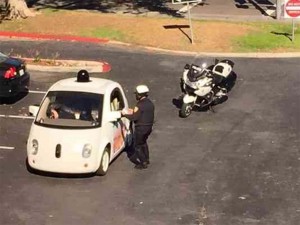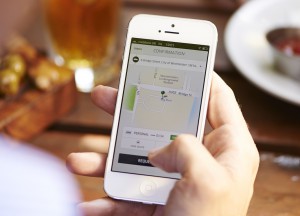
A Mountain View, CA police officer recently gave a warning to a Google Car for driving too slowly. Photo courtesy Google autonomous vehicle blog.
Google plans to spin off its autonomous vehicle operations next year, turning the unit into a stand-alone business under the corporate umbrella of Alphabet, Inc.
That could serve as a prelude to actually putting the company’s first self-driving vehicles on the road in a commercial application, according to a report by the Bloomberg news service. While Google has clocked more than 1 million miles testing its autonomous technology it has not laid out a public plan for turning that research into an actual, for-profit business.
But a plan to put driverless cars on the road, possibly through a new ride-sharing service to compete with the likes of Uber and Lyft, could be endangered by draft regulations proposed by the State of California. Those new rules would require all vehicles to have conventional controls, including steering wheel and pedals, with a trained “operator” behind the wheel in case of a system failure.
If the Bloomberg report is accurate, it appears to mark a shift in strategy for Google which announced in September it was not immediately planning to make the unit a standalone business. But it noted it would be “a good candidate to become one at some point in the future.”
A move to make that happen more quickly might indicate the influence of John Krafcik, the former CEO of Hyundai Motor America, who was hired to run Google’s autonomous vehicle operations in September after serving a brief stint with online auto service TrueCar.
What other changes might be in store is uncertain but there are numerous questions about how Google actually plans to make a business case for its self-driving efforts after spending millions of dollars during a decade of advanced research.
The company has so far said it does not plan to get directly into the car manufacturing business, a position that has been taken to mean it will instead license its technology to other manufacturers who might want to kick-start their own autonomous vehicle operations.
But Google did partner with Michigan automotive supplier Roush Enterprises to develop a bubble-shaped autonomous vehicle widely known as the “Google Car.” Ultimately, it plans to put 100 of them into use around its corporate campuses in San Francisco and Austin. The first of those prototypes are equipped with steering wheel and gas and brake pedals, but later versions were intended to have nothing but an emergency shutoff switch.
That plan may now be in jeopardy as a result of the new California Department of Motor Vehicle draft rules which would demand that a specially trained “operator” always be in an autonomous vehicle, ready to take over in an emergency. The regulations also would require conventional vehicle controls.
(Click Here to learn more about the new California rules.)
Google issued a statement saying it was “gravely disappointed” by the plan, and it may seek to modify the rules before they are enacted. It could also seek changes later, as autonomous vehicles start becoming more commonplace.
Currently, there are scores of self-driving prototypes on the road around the country, many of them in California. Tesla recently launched the first semi-autonomous vehicle, a Model S battery sedan updated to use the maker’s AutoPilot system, capable of hands-free driving on a limited-access highway. Nissan has laid out plans to put its first fully autonomous vehicle in production by 2020, and Britain’s Juniper Research forecasts nearly 20 million such vehicles will be in use around the world by 2025.
(For more on the Juniper autonomous vehicle study, Click Here.)
Most, if not all, would still be equipped with conventional controls and require a human seated behind them, ready to take control in an emergency. But Google and other proponents of even more advanced systems envision a time when driverless cars could roam the roads much like manned taxis do today.
Travis Kalanick, the CEO of ride-sharing firm Uber, has made it clear he would like to switch to driverless vehicles in order to cut the cost of operations – and to boost profits. Google has said the technology would also enhance mobility for the elderly and physically handicapped.
Sergey Brin, a Google co-founder, said earlier this year that the company could use its autonomous technology to launch a ride-sharing service of its own.
While the public appears to be warming to the idea of autonomous vehicles, according to a series of recent surveys, there’s still a reluctance to get into a car with no one behind the wheel. The vast majority of American adults told one poll recently that they’d be reluctant to let a child get into such a vehicle to be taken to school.
(Ford launches autonomous vehicle testing in California. Click Here for the story.)



Driving too slowly in traffic will cause so much road rage that the Google bubble machines are likely to end up in the ditch with some very shaken up passengers. Then the AV lawsuits will start in earnest.
A new technology introduced by one of the biggest automobile companies, Volvo, will ensure that your car
avoid accidents on the roads involving pedestrians.
Once you do that take a spray bottle filled with 4 cups
of warm water and a tablespoon of detergent and spray the
stain. According to Campbell Fuller, spokesman for
the ICA, buyers need to contact their insurer before agreeing to a purchase.